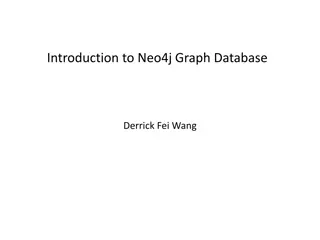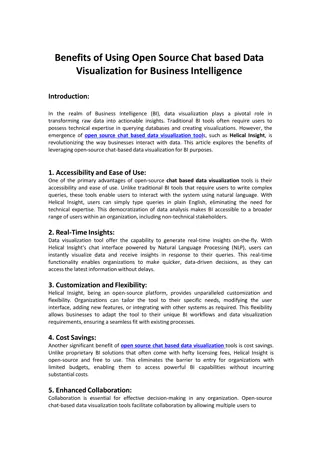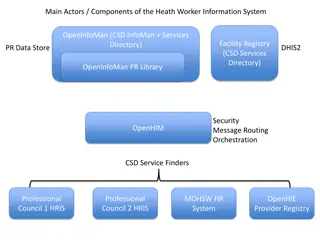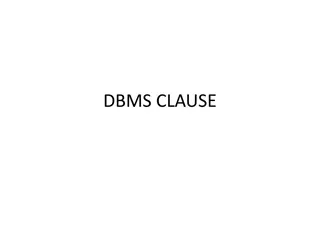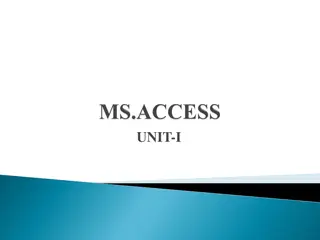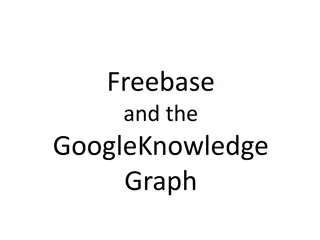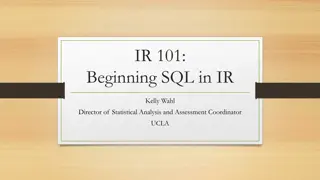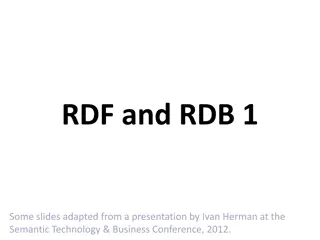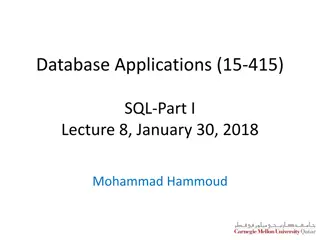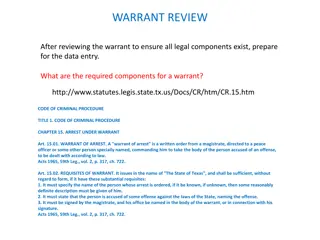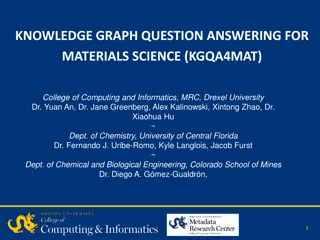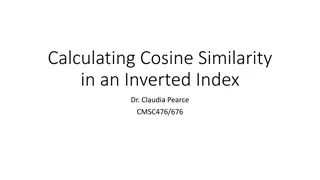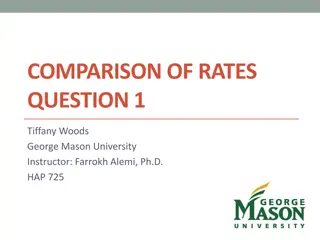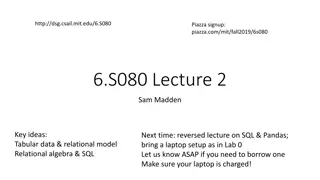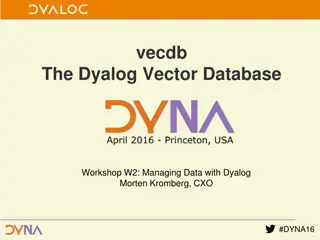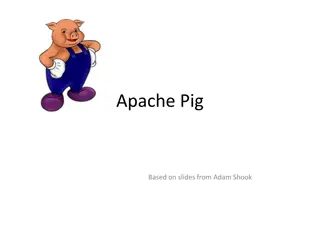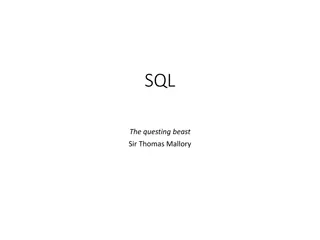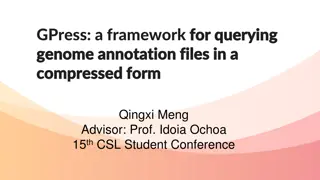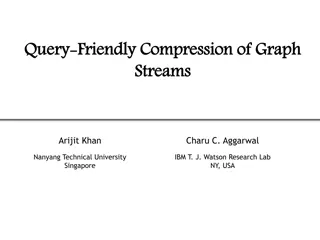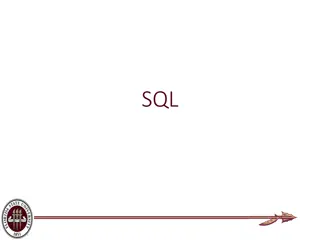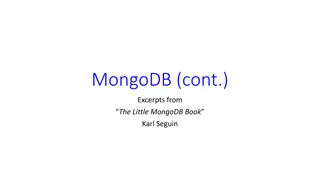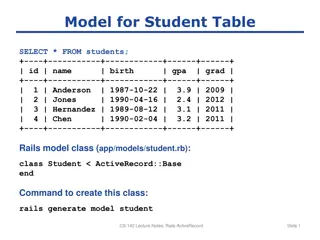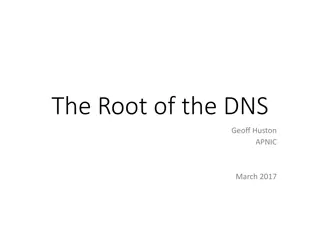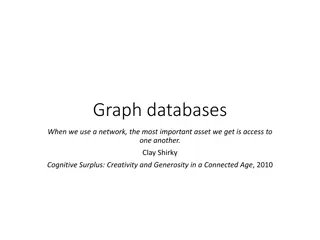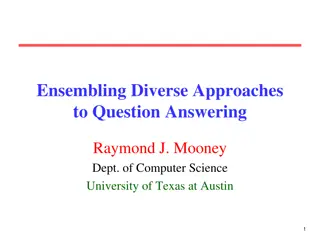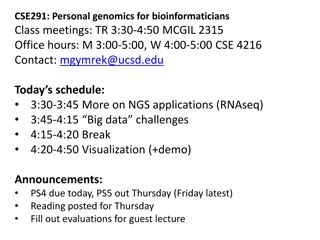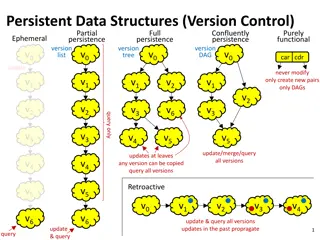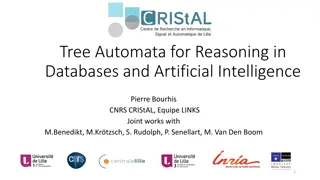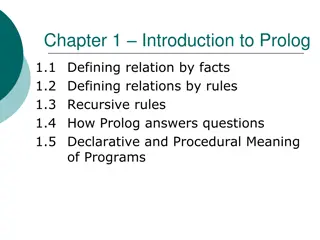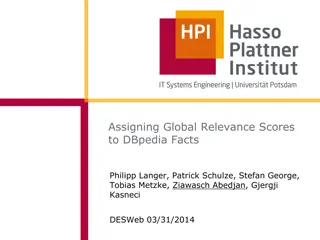Neo4j Graph Database Fundamentals
This comprehensive presentation delves into the fundamentals of Neo4j graph database, covering topics such as the definition of graph databases, reasons for their usage, insights into Neo4j and Cypher, practical applications like data flow analysis, and hands-on instructions on creating and querying
1 views • 20 slides
Benefits of Open Source Chat-based Data Visualization
In the realm of Business Intelligence (BI), data visualization plays a pivotal role in transforming raw data into actionable insights. Traditional BI tools often require users to possess technical expertise in querying databases and creating visualizations. However, the emergence of open source chat
1 views • 2 slides
Overview of Health Worker Information System Components
Explore the various components of the Health Worker Information System, from registering new health workers to updating their credentials and querying for information. This system involves OpenInfoMan, Facility Registry, DHIS2, PR Data Store, Professional Councils, MOHSW HR System, and OpenHIE Provi
0 views • 7 slides
Graph-Based Data Science: Opportunities, Challenges, and Techniques
Graph-based data science offers a powerful approach to analyzing data by leveraging graph structures. This involves using graph representation, analysis algorithms, ML/AI techniques, kernels, embeddings, and neural networks. Real-world examples show the utility of data graphs in various domains like
3 views • 37 slides
WHERE Clause in DBMS
The WHERE clause in a database management system (DBMS) is used to fetch filtered data based on specific criteria or patterns. Operators such as >, >=, <, <=, =, <>, BETWEEN, LIKE, and IN can be used with the WHERE clause to define filtering conditions. This article explains the usage of WHERE claus
1 views • 24 slides
Microsoft Access: A Comprehensive Overview
Microsoft Access is a powerful Database Management System (DBMS) that integrates the relational Microsoft Jet Database Engine with a user-friendly graphical interface. It is a key component of the Microsoft Office suite, offering tools for database creation, data input, querying, and report generati
0 views • 18 slides
Evolution of Freebase and the Google Knowledge Graph
Freebase was initially created in 2005 as an open shared database of knowledge, later acquired by Google and absorbed into the Google Knowledge Graph. Its approach included crowdsourcing updates and additions, focusing on data rather than text. The schema of Freebase included around 1500 types, 3500
2 views • 12 slides
Introduction to SQL: Learn the Basics and Beyond
Explore the world of Structured Query Language (SQL) with this comprehensive guide. Discover what SQL is, its history, usage, and how to learn it on your own through free online tutorials. Understand the properties of relational databases and get insights into designing a relational database. With S
0 views • 29 slides
Exporting Relational Data to RDF: Strategies and Considerations
Explore the process of mapping relational data to RDF, including the choice of RDF vocabulary, defining mapping techniques, and exporting strategies. Learn about RDB systems that support RDF, direct mapping approaches, and the use of hybrid storage solutions. Discover how to bridge SPARQL and SQL fo
4 views • 13 slides
Introduction to Database Systems and SQL Programming
Understanding database systems is crucial in today's digital world. Explore the basics of database systems, SQL statements, and Java Database Connectivity (JDBC) in this comprehensive overview. Learn about DBMS, SQL querying, JDBC API, and more to enhance your understanding of managing and interacti
10 views • 24 slides
SQL: Major Aspects and Functionality in Database Applications
SQL, as a relational database language, offers Data Manipulation Language (DML) and Data Definition Language (DDL) for querying and modifying data. Additionally, SQL encompasses triggers, embedded code execution, remote database access, transaction management, and security features for efficient dat
1 views • 52 slides
Restructuring Fees Inventory File: Updates and Changes Overview
The restructuring of the Fees Inventory File includes the reclassification of fees to streamline the collection of tuition and fee information. Expertise from financial professionals like David Cummins and Frederick Church guided the process. The goal is to enhance institutional benchmarking, elimin
0 views • 16 slides
Essential Components of a Warrant: Legal Requirements and Data Entry Process
In preparing for data entry after reviewing a warrant, ensure the necessary components are in place. These components include the name of the accused, details of the offense, signature of the magistrate, and more as specified under the Texas Code of Criminal Procedure. The process also involves quer
0 views • 36 slides
Advancements in Knowledge Graph Question Answering for Materials Science
Investigating natural language interfaces for querying structured MOF data stored in a knowledge graph, this project focuses on developing strategies using NLP to translate NL questions to KG queries. The MOF-KG integrates datasets, enabling query, computation, and reasoning for deriving new knowled
1 views • 13 slides
Cosine Similarity in Inverted Index for Querying
In this document, Dr. Claudia Pearce explains how to build and query from an inverted index, focusing on calculating the Cosine Similarity. The process involves calculating the dot product of terms in the document and query, updating sums based on term weights, and understanding the significance of
0 views • 15 slides
Constructing Control Chart for Prophylactic Antibiotic Overuse Rate at Southeast Alabama Medical Center
In this project, we need to create a control chart showing the rate of prophylactic antibiotic overuse over time at Southeast Alabama Medical Center. The process involves downloading data from Medicare, importing it into Microsoft SQL Server, and querying the tables to extract specific information f
0 views • 13 slides
Crowd Mining: Humanity's Collective Mind Expansion
The concept of Crowd Mining involves searching for patterns in an open world with imprecise questions, requiring a new type of crowd-assisted mining process. It involves querying understanding, identifying relevant information sources, and interactive mining of human and computerized knowledge. Crow
0 views • 5 slides
Introduction to Tabular Data Modeling and SQL Concepts
Explore the fundamentals of tabular data modeling, relational algebra, SQL, and database relationships through practical examples. Learn about key concepts such as primary keys, tuples, and different types of relationships in database management. Get hands-on experience using Pandas and SQL for data
1 views • 30 slides
Managing Data with Dyalog: The VecDb Workshop
The VecDb workshop discusses the concept of Inverted Databases, highlighting their advantages and weaknesses. It aims to provide a simple, fast storage mechanism for data, emphasizing parallel queries and integration with Dyalog APL. The workshop covers creating databases, querying data, and the goa
0 views • 12 slides
Introduction to Apache Pig: A High-level Overview
Apache Pig is a data flow language developed by Yahoo! and is a top-level Apache project that enables non-Java programmers to access and analyze data on a cluster. It interprets Pig Latin commands to generate MapReduce jobs, simplifying data summarization, reporting, and querying tasks. Pig operates
0 views • 57 slides
Lists and List Operations in Python
This content provides valuable insights into lists in Python, covering topics such as list creation, querying, modification, loop examples, the range function, list operations, and list querying expressions. It explains the concepts with examples, images, and practical demonstrations, making it easi
0 views • 32 slides
Python Lists Operations
Python lists are versatile data structures that allow for efficient creation, querying, modification, insertion, removal, replacement, and rearrangement of elements. This comprehensive guide covers essential list operations such as extracting parts of a list, finding elements, and altering list cont
0 views • 18 slides
SQL: A Comprehensive Guide to Database Querying and Management
SQL, a widely utilized database language, is essential for data management and querying. It offers a complete set of commands for data definition, manipulation, and maintenance, making it a vital skill in today's tech industry. Learn about data types, constraints, and check constraints in SQL, along
0 views • 72 slides
GPress: A Framework for Querying Genome Annotation Files in Compressed Form
Genome projects generate large GFF files which require significant storage space. GPress offers a solution by compressing GFF files while allowing quick searches and random access. The framework addresses challenges faced by current GFF utilities, providing a more efficient approach to managing and
0 views • 24 slides
Challenges in Querying Graph Streams for Friendly Compression
Graph streams pose challenges in querying due to trade-offs among space, accuracy, and efficiency. The need to balance space and accuracy while maintaining throughput presents obstacles in constructing summaries and incorporating incremental updates. Additional challenges include query expressibilit
0 views • 28 slides
SQL - Introduction and Basics
SQL (Structured Query Language) is a standard language for querying and manipulating data. It includes Data Definition Language (DDL) for creating, altering, and deleting tables, Data Manipulation Language (DML) for querying tables and modifying data, and more. Tables in SQL consist of attributes li
0 views • 30 slides
Easy Ada Tooling with Libadalang
Explore the functionalities and benefits of using Libadalang for Ada programming, including querying and altering data, incremental error recovery, syntax analysis, semantic tolerance, and more. Discover how this tool enables easy binding generation to multiple languages and ecosystems, facilitating
0 views • 16 slides
MongoDB: Array Operations, Data Modeling, and NoSQL Concepts
Delve into MongoDB array operations such as accessing array elements with $slice, data modeling concepts, and the absence of joins in NoSQL systems. Learn how MongoDB handles relationships, querying nested data, and the nuances of data modeling in comparison to relational databases.
0 views • 43 slides
Managing BEAST Alarm System: Enhancing Alarm Monitoring and Analysis
Explore how managing the BEAST alarm system with a detailed alarm history helps in better understanding event sequences, producing alarm statistics, identifying nuisance alarms, and finding patterns. The operations alarm dashboard provides visualization, trends, and statistics with advanced filterin
0 views • 5 slides
Modeling Complete and Incomplete Data in Database Systems
The discussion revolves around the partial-closed world assumption, contrasting incompleteness as default (IAD) with completeness as default (CAD). It delves into querying completeness reasoning, translating between CAD and IAD, and the implications of using IAD over CAD in database modeling. Variou
1 views • 13 slides
Rails ActiveRecord: A Comprehensive Overview
The content provides a detailed guide on working with Rails ActiveRecord, focusing on creating, reading, updating, and deleting records in a student table. It covers model creation, data manipulation commands, querying data, and examples of controller and view implementations. The material also touc
0 views • 13 slides
The Domain Name System (DNS) Structure
The Domain Name System (DNS) is a distributed data collection utilizing a delegation hierarchy to reflect the hierarchical structure of domain names. This system resolves DNS names by discovering information through iterative searches, starting from the root zone. The process involves querying serve
0 views • 25 slides
Graph Databases and Neo4j
Graph databases offer a flexible way to manage data by representing relationships between nodes. Neo4j is a popular graph database system that uses Cypher for querying. This guide provides insights into graph database concepts, advantages, and getting started with Neo4j, including creating nodes and
1 views • 39 slides
Ensembling Diverse Approaches to Question Answering
Diverse types of question answering approaches include factoid querying, compositional querying of structured databases/knowledge graphs, reading comprehension, and visual question answering. Limitations of factoid question answering are also discussed, highlighting the need for specific queries and
0 views • 28 slides
NGS Applications in Bioinformatics
Explore the world of Next-Generation Sequencing (NGS) applications in bioinformatics, covering topics such as RNA sequencing, big data challenges, storing genomic datasets, querying genetic information, and data visualization. Dive into the complexities of sequencing technologies, gene expression co
0 views • 41 slides
Persistent Data Structures and Version Control
Exploring persistent data structures and version control concepts, including partial persistence, full confluence, purely functional approaches, and ephemeral versions. Delve into tree lists, full and partial persistence, query methods, retroactive updates, planar point location, path copying in tre
0 views • 9 slides
MongoDB Atlas Overview and Tutorial
MongoDB Atlas is a fully-managed cloud Database-as-a-Service offering by MongoDB. This tutorial provides a step-by-step guide on how to set up a free MongoDB Atlas account, create databases and collections, add database users, and explore and manipulate your data using MongoDB Compass. The tutorial
3 views • 34 slides
Automata for Query Optimization in Databases and AI
Explore the use of tree automata for reasoning, querying databases using logic languages, optimizing queries through relation algebra, and core problems in query optimization. Learn about data exchange on the web, inference of information from incomplete data, and the semantics of Datalog programs f
0 views • 44 slides
Overview of Prolog Programming Paradigm
Prolog is a logic programming language that defines relations through facts and rules, allowing recursive rules for powerful computations. It provides a declarative way of expressing programs and offers flexibility in knowledge representation. The language uses clauses, predicates, and variables to
0 views • 19 slides
Enhancing Relevance with Global Scores for DBpedia Facts
Explore the advantages of structured data over unstructured data, learn about querying YAGO and DBpedia for specific classes, and discover challenges and strategies in text extraction and ranking within the DBpedia framework. The overview delves into web applications, ranking strategies, and user st
0 views • 20 slides
